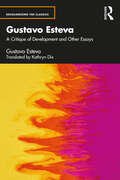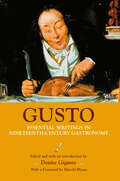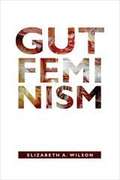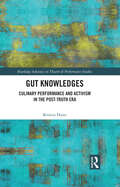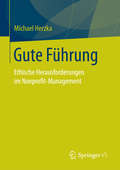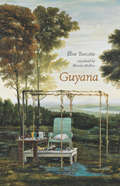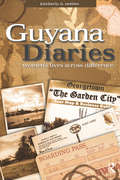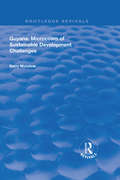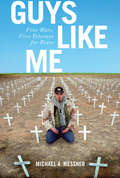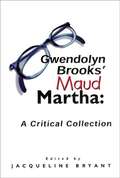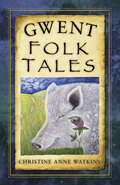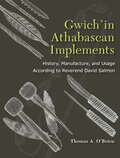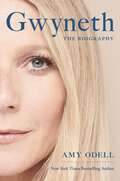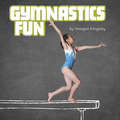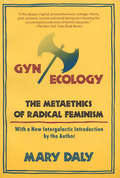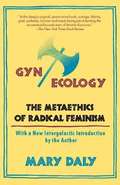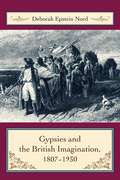- Table View
- List View
Gustavo Esteva: A Critique of Development and other essays (Decolonizing the Classics)
by Gustavo EstevaIn his reflections on decolonization and post-development, Gustavo Esteva forged a unique synthesis of critical theory and political economy. This book presents more than half a century of "reflection in action" in the form of essays, books, and interventions in national and international forums and newspaper articles—most published here for the very first time. It showcases Esteva’s evolving thought on economic theory, social change, revolutionary subjectivity, transition, development, the challenges of a new era and personal and communal autonomy, all associated with the challenges and advances in the construction of a new society. Through this translation, Esteva’s writings engage with many of the important cultural and political debates of the present day and retain their power both to provoke and move the reader. Readers will see a thinker at work, formulating local, grassroots alternatives as they are emerging in Mexico and Latin America, with a keen sensibility to what happens in other regions of the world. Gustavo Esteva: A Critique of Development and Other Essays offers a lucid insight into the climatic and sociopolitical collapses we face and will be of interest to students and scholars of critical theory, post-colonial and de-colonial studies, and post-development studies.
Gusto for Things: A History of Objects in Seventeenth-Century Rome
by Renata AgoWe live in a material worldOCoour homes are filled with things, from electronics to curios and hand-me-downs, that disclose as much about us and our aspirations as they do about current trends. But we are not the first: the early modern period was a time of expanding consumption, when objects began to play an important role in defining gender as well as social status. "Gusto for Things" reconstructs the material lives of seventeenth-century Romans, exploring new ways of thinking about the meaning of "things" as a historical phenomenon. aThrough creative use of account books, inventories, wills, and other records, Renata Ago examines early modern attitudes toward possessions, asking what people did with their things, why they wrote about them, and how they passed objects on to their heirs. While some inhabitants of Rome were connoisseurs of the paintings, books, and curiosities that made the city famous, Ago shows that men and women of lesser means also filled their homes with a more modest array of goods. She also discovers the genealogies of certain categories of thingsOCofor instance, books went from being classed as luxury goods to a category all their ownOCoand considers what that reveals about the early modern era. An animated investigation into the relationship between people and the things they buy, "Gusto for Things" paints an illuminating portrait of the meaning of objects in preindustrial Europe. "
Gusto: Essential Writings in Nineteenth-Century Gastronomy
by Denise GiganteFirst published in 2006. Routledge is an imprint of Taylor & Francis, an informa company.
Gut Anthro: An Experiment in Thinking with Microbes
by Amber BenezraA fascinating ethnography of microbes that opens up new spaces for anthropological inquiry The trillions of microbes in and on our bodies are determined by not only biology but also our social connections. Gut Anthro tells the fascinating story of how a sociocultural anthropologist developed a collaborative &“anthropology of microbes&” with a human microbial ecologist to address global health crises across disciplines. It asks: what would it mean for anthropology to act with science? Based partly at a preeminent U.S. lab studying the human microbiome, the Center for Genome Sciences at Washington University, and partly at a field site in Bangladesh studying infant malnutrition, it examines how microbes travel between human guts in the &“field&” and in microbiome laboratories, influencing definitions of health and disease, and how the microbiome can change our views on evolution, agency, and life.As lab scientists studied the interrelationships between gut microbes and malnutrition in resource-poor countries, Amber Benezra explored ways to reconcile the scale and speed differences between the lab, the intimate biosocial practices of Bangladeshi mothers and their children, and the looming structural violence of poverty. In vital ways, Gut Anthro is about what it means to collaborate—with mothers, local field researchers in Bangladesh, massive philanthropic global health organizations, with the microbiome scientists, and, of course, with microbes. It follows microbes through various enactments in scientific research—microbes as kin, as data, and as race. Revealing how racial categories are used in microbiome research, Benezra argues that microbial differences need transdisciplinary collaboration to address racial health disparities without reifying race as a straightforward biological or social designation.Gut Anthro is a tour de force of science studies and medical anthropology as well as an intensely personal and deeply theoretical accounting of what it means to do anthropology today. Cover alt text:Black background overlaid with a pink organic path suggestive of a human digestive system. Title appears within the guts as if being processed.
Gut Feminism
by Elizabeth A. WilsonIn Gut Feminism Elizabeth A. Wilson urges feminists to rethink their resistance to biological and pharmaceutical data. Turning her attention to the gut and depression, she asks what conceptual and methodological innovations become possible when feminist theory isn't so instinctively antibiological. She examines research on anti-depressants, placebos, transference, phantasy, eating disorders and suicidality with two goals in mind: to show how pharmaceutical data can be useful for feminist theory, and to address the necessary role of aggression in feminist politics. Gut Feminism's provocative challenge to feminist theory is that it would be more powerful if it could attend to biological data and tolerate its own capacity for harm.
Gut Knowledges: Culinary Performance and Activism in the Post-Truth Era (Routledge Advances in Theatre & Performance Studies)
by Kristin HuntThis book examines historical and contemporary activist alimentary performance with an eye toward, or perhaps a taste for, what these performance modes can reveal about changing relationships between the senses, truth, justice, and ethical action amid the post-truth era’s destabilization of shared notions of truth. This inquiry emerges in response to an urgent need to understand how multisensory models of knowledge, truth, and justice can be ethically employed to nurture a more just society. Alongside this goal is a drive to understand the ways in which these modes of performance are being co-opted by authoritarians, white supremacists, anti-science activists, and others to shore up injustice, promote misinformation, and anxiously guard existing systems of power and privilege. From white supremacist milk-drinking performances to liberatory uses of culinary performance as pedagogy, Kristin Hunt analyzes both disturbing and inspiring alimentary events to understand how performers, cooks, scholars, artists, and activists can effectively cultivate models of alimentary performance that center plenitude, joy, and justice while pushing back against models rooted in anxiety, diminishment, and cruelty. The text should be of interest for students in performance studies, contemporary theatre, and theatre history as well as courses in food studies and popular culture.
Gute Führung: Ethische Herausforderungen im Nonprofit-Management
by Michael HerzkaIm Spannungsfeld von Ökonomie und Ethik müssen Führungskräfte vielfältigen Erwartungen gerecht werden. Organisationen im Sozial- Bildungs- und Gesundheitswesen erfüllen einen gemeinwohlorientierten und gemeinschaftsbildenden Auftrag, sie begleiten, unterstützen und fördern Menschen in schwierigen Lebenssituationen. Gleichzeitig sollen sie nach betriebswirtschaftlichen Grundsätzen geführt werden. Daraus ergeben sich ethische Fragen, die sich im Management und in der Führung von Mitarbeitenden manifestieren. Fairness, Transparenz und Vertrauen sind unabdingbar. Es wird zunehmend erforderlich, im doppelten Sinne ökonomisch und moralisch ‚gutes‘ Führungshandeln zu reflektieren und neu zu bestimmen. Der Autor zeigt praxisnah, wie das vorhandene professionsethische Instrumentarium im Sinne einer angewandten Führungsethik weiterentwickelt werden kann.
Gute Pflege im transkulturellen Vergleich: Eine Studie in der stationären Altenpflege unter Betrachtung immaterieller Werte (Forum Gesundheitsmanagement)
by Bouchra AchoumrarVor dem Hintergrund eines vielfältigen soziokulturellen Umfeldes des Gesundheits- und Pflegewesens gewinnt die Versorgungsqualität im transkulturellen Kontext kontinuierlich an Bedeutung für die professionelle Pflegepraxis und pflegewissenschaftliche Forschung. Nicht zuletzt aufgrund der sozialpolitischen und ökonomischen Vorgaben wird in den Handlungsfeldern der pflegerischen Praxis die Sicherstellung hoher Versorgungsqualität unter Berücksichtigung der Bedürfnisse sämtlicher potenzieller Anspruchsgruppen angestrebt. Zugleich kommt in Anbetracht der knappen Ressourcen in der Altenpflege sämtlichen materiellen und immateriellen Faktoren eine wichtige Relevanz für eine optimale Erreichung qualitativer sowie wirtschaftlicher Ziele zu. Das vorliegende Buch trägt zu einem vertieften Verständnis dessen bei, welche qualitativen Merkmale, Anforderungen und Handlungsweisen einer guten Pflege im transkulturellen Kontext im Setting stationärer Altenpflege seitens Pflegebedürftiger und beruflicher Akteurinnen und Akteure zugeschrieben werden. Neben der Beantwortung pflegewissenschaftlicher Fragestellungen wird unter Bezugnahme auf betriebswirtschaftliche Zusammenhänge ein Beitrag zur empirischen Fundierung und konzeptionellen Weiterentwicklung sogenannter „immaterieller Werte“ in der stationären Altenpflege geleistet.
Guyana
by Rhonda Mullins Elise TurcotteAna and her son, Philippe, are grieving the loss of Philippe's father when Ana's hairstylist Kimi dies in an apparent suicide. Driven by a force she doesn't understand, Ana starts digging into Kimi's past in Guyana in 1978, which leads to nested tales of north and south, past and present, and to the Jonestown Massacre. A stunning translation of a masterpiece by one of Quebec's most important novelists.Elise Turcotte is a novelist and award-winning poet who has twice received the Prix Emile-Nelligan.Rhonda Mullins was a finalist for the 2007 Governor General's Literary Award for Translation and translated Jocelyne Saucier's And the Birds Rained Down.
Guyana Diaries: Women's Lives Across Difference (Writing Lives: Ethnographic Narratives)
by Kimberly D NettlesGuyana Diaries narrates the life histories of members of the Red Thread Development Corporation, a group of women activists in the Caribbean. Kimberly Nettles, an African American researcher, explores the impact of their work on these women’s lives and, in the process, discovers differences of class and nation that overshadow the gender and race she shares with her subjects. Blending feminist ethnography, critical autobiography, and literary narratives, Nettles examines both the collective and her own experiences in studying its members, producing an illuminating, evocative work of self and other. It should be of interest to those in race and ethnic studies, gender studies, Caribbean studies, development studies, and qualitative research.
Guyana: Microcosm of Sustainable Development Challenges (Routledge Revivals)
by Barry MunslowFirst published in 1998, this volume uses Guyana as an excellent, comprehensive case study to examine various sectors’ operations, effects upon the environment and the ways in which the sector can impact upon the vitality and development potential of other sectors. The authors attempt to demonstrate how it is possible to adjust current sectoral activities for improved resource utilisation. They begin in the interior looking at mining and forest resource exploitation. Attention then moves towards the coast, looking at agriculture, fishing, human settlement and service provision. A review of industry, transport and energy follows before examining biodiversity, tourism and the Amerindian community. Finally, a detailed analysis is presented of the challenges to be faced in devising a sustainable development national strategy.
Guyland: The Perilous World Where Boys Become Men
by Michael KimmelOne of the most eminent scholars and writers on men and masculinity and the author of the critically acclaimed Manhood in America turns his attention to the culture of guys, aged 16 to 26: their attitudes, their relationships, their rules, and their rituals.“Kimmel is our seasoned guide into a world that, unless we are guys, we barely know exists. As he walks with us through dark territories, he points out the significant and reflects on its meaning.”—Mary Pipher, Ph.D., author of Reviving OpheliaThe passage from adolescence to adulthood was once clear. Today, growing up has become more complex and confusing, as young men drift casually through college and beyond—hanging out, partying, playing with tech toys, watching sports. But beneath the appearance of a simple extended boyhood, a more dangerous social world has developed, far away from the traditional signposts and cultural signals that once helped boys navigate their way to manhood—a territory Michael Kimmel has identified as "Guyland."In mapping the troubling social world where men are now made, Kimmel offers a view into the minds and times of America's sons, brothers, and boyfriends, and he works toward redefining what it means to be a man today—and tomorrow. Only by understanding this world and this life stage can we enable young men to chart their own paths, stay true to themselves, and emerge safely from Guyland as responsible and fully formed male adults.
Guys Like Girls Named Jennie
by Kerri PomarolliThis book is an inspirational, comical, and honest look at the dating scene through the eyes of a Christian woman who is trying to live up to God's standards in today's society.
Guys Like Me: Five Wars, Five Veterans for Peace
by Michael A. MessnerOver the last few decades, as the United States has become embroiled in foreign war after foreign war, some of the most vocal activists for peace have been veterans. These veterans for peace come from all different races, classes, regions, and generations. What common motivations unite them and fuel their activism? Guys Like Me introduces us to five ordinary men who have done extraordinary work as peace activists: World War II veteran Ernie Sanchez, Korean War veteran Woody Powell, Vietnam veteran Gregory Ross, Gulf War veteran Daniel Craig, and Operation Iraqi Freedom veteran Jonathan Hutto. Acclaimed sociologist Michael Messner offers rich profiles of each man, recounting what led him to join the armed forces, what he experienced when fighting overseas, and the guilt and trauma he experienced upon returning home. He reveals how the pain and horror of the battlefront motivated these onetime warriors to reconcile with former enemies, get involved as political activists, and help younger generations of soldiers. Guys Like Me is an inspiring multigenerational saga of men who were physically or psychically wounded by war, but are committed to healing themselves and others, forging a path to justice, and replacing endless war with lasting peace
Guys Write for Guys Read
by Jon ScieszkaThis fast-paced, high-energy collection of 92 short works features today's most popular writers and illustrators writing about what it means to be a guy. Contributors include Chris Crutcher, Stephen King, Matt Groening, Daniel Pinkwater, Neil Gaiman, and many more. Includes an all-new foreword by Jon Scieszka and an excerpt from Knucklehead.
Gwendolyn Brooks' Maud Martha: A Critical Collection
by Elaine Richardson D. H. Melhem Larry Andrews Regina Jennings Maria K. Mootry Jacqueline Bryant B. J. Bolden Kelly Norman Ellis Dolores Kendrick Adele S. Newson-Horst Dorothy Randall TsurutaThis book of ctritical essays and commentary by eleven authors is on Gwendolyn Brooks' only novel, Maud Martha, published in 1953. The essays provide deep insight and understanding of the world that Brooks describes. The authors are active in Literary Criticism, Women Studies and African American Studies and bring those perspectives to their writing.
Gwent Folk Tales
by Christine Anne WatkinsGwent teems with stories of magic and strange transformations above and below ground. To tell them afresh, storyteller Christine Watkins has searched out of darkness through a maze of mountain mist and salvaged a wisewoman’s ironstone from the river. Read on to discover how and why the star-browed ox walked through a dream, what happened when Pegws found herself without Reverend Ridge in Carmel Chapel, and how the owl flew in low over the foxgloves, trying to sense from which direction change might come . . . Gwent Folk Tales brings to life long-told tales and weaves them beautifully with stories told to the author by family members. Wonderfully illustrated and engaging, there is a tale for everyone.
Gwich'in Athabascan Implements: History, Manufacture, and Usage According to Reverend David Salmon
by Thomas A. O’BrienThe most detailed and well-illustrated study of material culture for any northern Athabascan language group to date, Gwich’in Athabascan Implements reproduces pre- and early post-contact tools that are historically important to the Athabaskan people. A long-term collaboration between anthropologist Thomas O’Brien and Athabascan elder David Salmon, this volume provides more than one hundred one-to-one sketches of a wide variety of implements, many of which are no longer commonly found in use.
Gwinnett County, Georgia (Black America Series)
by Jennifer E. Cheeks-CollinsThe African-American community of Gwinnett County boasts a rich heritage brought to life in scenes captured by early photography. These residents faced challenges and hardships both during and after slavery and entered into the turbulent 20th century poised for social change; theirs is an engaging story told by the proud faces in this volume. Men and women who built homes and businesses, who defended their country in times of war, and who educated their young make up the diverse and determined African-American citizenry of this greater Atlanta community.
Gwyneth: The Biography
by Amy OdellPraise for the New York Times bestseller Anna: The Biography &“Odell&’s insights...are fascinating.&” —The New York Times &“A wonderful romp through Wintour&’s world: couture at its juiciest.&” —The Washington Post New York Times bestselling author Amy Odell takes readers inside the world of one of the most influential and polarizing celebrities of the modern era—complete with exclusive new stories about her childhood, acting career, romances, and her lifestyle brand Goop.Love her or hate her, Gwyneth Paltrow has managed to stay on the A-list, her influence spanning entertainment, fashion, and the modern wellness industry. Gwyneth was born to parents viewed as Hollywood royalty, and that immense privilege turned her into a target of backlash when, at just twenty-six, she won an Oscar. Rather than cave in to criticism, she leveraged the attention for valuable endorsement deals and film roles, eventually founding her controversial wellness and lifestyle company, Goop. Over the decades, she has participated in countless carefully managed interviews, but the real Gwyneth—the basis of her motives, desires, strengths, faults, and vulnerabilities—has never been fully revealed, until now. Based on exclusive conversations with more than 220 sources, including close current and former friends and colleagues, this deeply researched biography provides insight and behind-the-scenes details of her relationships, family, friendships, iconic films, and tenure as the CEO of Goop. Gwyneth offers the fascinating, definitive look at how Paltrow rose to prominence, stayed in the limelight, and shaped culture—for better or worse—for so long.
Gyeongju: The Capital of Golden Silla (Cities of the Ancient World)
by Sarah Milledge NelsonGyeongju, the capital of the Kingdom of Silla, grew from a loose confederation of villages, called Saro, to become the capital of most of the Korean peninsula. Its relationships with Japan, the Eurasian Steppes, and countries along the Silk Road leading to Europe helped to make the city one of the most prosperous and significant in ancient East Asia. In this seminal new volume, Sarah Milledge Nelson draws on over 30 years’ experience to offer the first complete history of this fascinating city. Gyeongju explores culture, class and rank, industry, international relations, rulers, and socio-cultural issues such as gender, and examines in detail the complex systems of class and rank, Gyeongju’s position as the royal seat of Silla, and the influence and legacy of the ancient city. Excavations in Gyeongju have provided evidence not only of the wealth and power of the monarchy, but also of production and agriculture, and the reach of Gyeongju’s trade routes, making this city a fascinating case study for the region. Augmented with extensive maps and images which illustrate the city’s rich history, this volume is crucial reading for anyone interested in the city, the kingdom of Silla, the history and archaeology of Korea, and early urbanism and state formation in East Asia.
Gymnastics Fun (Sports Fun)
by Imogen KingsleyGymnastics is amazing to watch! Kids can take part in the sport by learning about the skills, equipment, and the importance of good sportsmanship. They can even practice a basic skill to have more fun in the arena.
Gyn/Ecology: The Metaethics of Radical Feminism
by Mary DalyThis revised edition includes a New Intergalactic Introduction by the Author. <P><P>Mary Daly's New Intergalactic Introduction explores her process as a Crafty Pirate on the Journey of Writing Gyn/Ecology and reveals the autobiographical context of this "Thunderbolt of Rage" that she first hurled against the patriarchs in 1979 and no hurls again in the Re-Surging Movement of Radical Feminism in the Be-Dazzling Nineties.
Gyn/Ecology: The Metaethics of Radical Feminism, with a New Intergalactic Introduction
by Mary DalyIn this book Daly argues that men throughout history have sought to oppress women. She moves beyond her previous thoughts on the history of patriarchy to the focus on the actual practices that, in her view, perpetuate patriarchy, which she calls a religion.
Gypsies and the British Imagination, 1807-1930
by Nord Deborah EpsteinDeborah Epstein Nord traces the nearly ubiquitous British preoccupation with Gypsies in imaginative works by John Clare, Walter Scott, William Wordsworth, George Eliot, Arthur Conan Doyle, and D. H. Lawrence.
